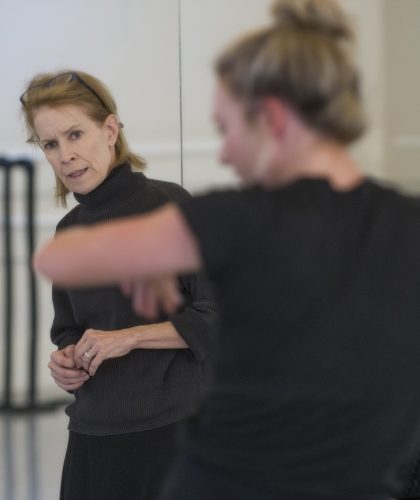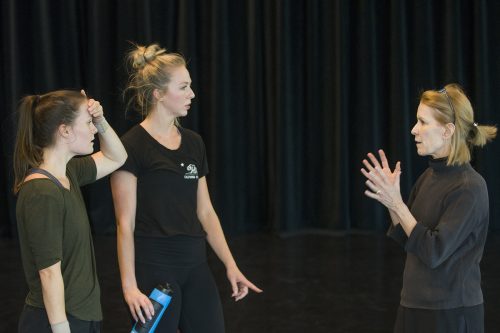Staying Young and Present Through Dance
Dance professor Susan Douglas Roberts explores liveliness and defining virtuosity as a performer.
Staying Young and Present Through Dance
Dance professor Susan Douglas Roberts explores liveliness and defining virtuosity as a performer.
Susan Douglas Roberts once thought virtuosity was about “external achievement, what it looked like.” But the professor of dance spent a 2017 sabbatical exploring “liveliness and the ways in which virtuosity is defined during various eras of a performer’s career.”

Susan Douglas Roberts worked with composer Gregory Biss to create nine short dance pieces reflecting the effects of time. Photo by Robert W. Hart
Douglas Roberts presented a concert in August that featured dancers older than 40, including herself. “Measuring Time” was inspired by composer Gregory Biss’ tribute to Robert Schumann’s “Scenes From Childhood,” a collection of short piano pieces.
In deciding to develop the concert, Douglas Roberts said she thought: “What a great challenge it would be to make a very, very short dance and be able to compose a whole idea in a minute, or just over a minute.”
In 2017, Douglas Roberts worked with Biss to compose nine dances about time, each about a minute long. Seven pieces were performed live, two were recorded on video, and all were performed or shown in Maine, where the professor has a home.
Mercy Sidbury, now 63, hadn’t danced in 15 years, although she does tai chi and Authentic Movement, a practice in self-directed motion done with eyes closed.
Using slow movements, Sidbury and Douglas Roberts, 61, danced a duet in an expression of trust and weight-sharing.
“I didn’t feel I needed to be anything but me.”
Marcy Sidbury, a 63-year-old who resumed dancing after 15 years
With eyes closed, Sidbury leaned her entire weight on Douglas Roberts and moved from an upright position to lying on the floor. “She’s just holding me, carrying me until I’m on the ground,” Sidbury said. “She settled my arm down on my head at the very end.”
Sidbury said audience members who were caring for aging parents were moved to tears seeing “this one person with eyes open carefully guiding the person with eyes closed who’s giving her weight over.”
Performing again was affirming, Sidbury said: “I didn’t feel I needed to be anything but me.”
Loretta Livingston’s performance was a whimsical dance with tea sets that ranged from demitasse to doll-sized. Douglas Roberts recorded and edited the video.
In some scenes Livingston looks tiny, framed by tree leaves; in others her hands fill the frame. It’s about “extreme variations in scale, because as a child things look very big from our point of view,” said Livingston, 68. “As we grow up, everything shrinks.”
Livingston, who still works as a dance maker and “movement actor,” adjusted her performance to accommodate a hip injury. She echoed Sidbury’s sentiment, saying, “I did not wear stage makeup. I didn’t try to disguise the way I look. … It is important to be the human being I am.”

Dance professor Susan Douglas Roberts, right, gives feedback to students during rehearsal in TCU’s Erma Lowe Hall. Douglas Roberts says that as she got older, she was better able to be present in her movements. Photo by Robert W. Hart
Before 2017, Douglas Roberts last took the stage to dance for family and friends when she turned 50. “When I was in my 20s, 30s, even 40s … I just wanted to go onstage with the patterns so ingrained that they were instinctual,” she said. “But it was more about the movement patterns and not moving the patterns.”
“Measuring Time” showed the professor how capable she is of being present throughout the entire creative process, from rehearsal to performance. “For me, virtuosity now is being able to stay in the moment and move in my body, not move my body.”
Inhabiting the “imagination, the dreams and the expectations of so many” has inspired her “own sense of possibility and imagination,” Douglas Roberts said. “I feel really lively right now.”

Your comments are welcome
Comments
Related reading:
Research + Discovery
Making the Mind-Body Connection in Dance
Jessica Zeller values student input and critical thinking over rote mimicry.
Campus News: Alma Matters, Research + Discovery
Uma Tauber’s Memory Tips
The cognitive psychologist explores how students, workers and the elderly retain information.
Alumni, Sports: Riff Ram
First Person with Lindsay Shoulders Westbrook ’06
The spirit coordinator and Showgirls director brought the iconic white boots to Horned Frog game day.